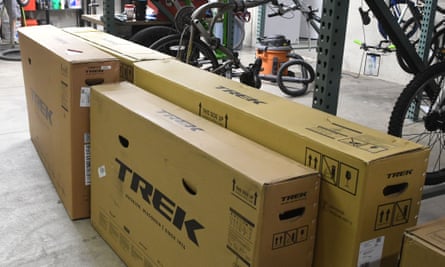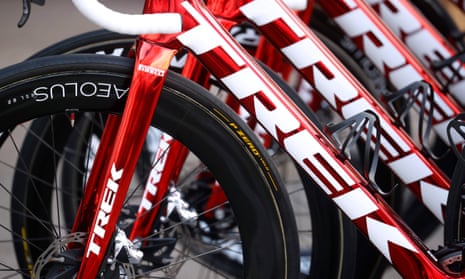Trek, one of the world’s biggest bicycle brands, recently released its sustainability report for 2021. Remarkably, this appears to be the first time a major bike company has published such a document.
While some other manufacturers make broad sustainability pledges or tout their success in reducing packaging waste, Trek’s report offers an ambitious array of concrete environmental commitments and a comprehensive analysis of the carbon footprint of its bikes.
This fills in an important gap in data. But many companies in other sectors have been releasing such environmental impact assessments for years. Why is this the first time we are seeing such a report from a major bicycle company, especially given that cycling is so widely touted as green?
That perception is a big part of the answer. Bike manufacturers have had a free ride in terms of tracking their own environmental impacts largely because of the assumption that biking is inherently environmentally friendly.
To be sure, cycling is one of the least environmentally impactful forms of transportation. Trek mentions this in its report, claiming, “If you ride about 430 miles you would have otherwise driven, you’ve saved the carbon equivalent of what it took to make your bike.” And Trek is right: in comparison with cars there is no contest.
An older and widely cited figure (based on a Dutch study and used by the European Cycling Federation) for the manufacturing footprint of bicycles is 96kg of carbon dioxide equivalent (CO2e). According to Trek, the production of a basic model of its bestselling bike – an entry-level mountain bike – emits about 100kg of CO2e.
The report provides a new figure for e-bikes. While the ECF estimates a manufacturing carbon footprint of 134kg, Trek’s figures show that electrifying any bike adds about 65kg of CO2e to production emissions. Making a basic commuter e-bike would therefore produce about 165kg of CO2e.
But compared with the manufacturing impact of a car, the differences between a conventional bike and an electric one are marginal. Making a small hatchback produces about 5.5 tonnes of CO2e. An electric version adds another 2-4 tonnes owing to the battery and electric motor. And manufacturing an SUV produces up to 13 tonnes.
A lifecycle analysis makes the disparities even starker. Assuming a lifetime travel of 19,200km, a bicycle’s emissions come out at about 25-35g CO2e/km (depending on food footprint, which can be highly variable). With Trek’s updated figure and assuming an EU average electricity mix, e-bikes come in at 21-25g CO2e/km (yes, e-bikes can be less carbon intensive than conventional bikes, assuming the rider is doing less work).
A typical car produces about 220g CO2e/km over 180,000 lifetime kilometres. Electric vehicles are better, averaging about 160g CO2e/km (depending on a country’s electricity emissions). There is little data on the lifecycles of e-scooters, but an estimate of a typical case in Germany is about the same as an electric car, at 165g CO2e/km.

However you cut it, compared with other forms of transportation, bikes have a much smaller carbon footprint. But does such a comparison always make sense? In addition to its entry-level mountain bike, Trek provides footprints for full-suspension mountain bikes, carbon-fibre electric mountain bikes, and its top-of-the-line aero road bikes.
While it markets its bikes as playing a critical role in decarbonising transportation systems, a lot of these models aren’t intended as alternatives to cars. In fact, some of them might be driven to the place where they are used.
This is the issue: in some cases, bikes are not transportation alternatives at all. They are a means of recreation, even a form of luxury goods. Of course, many people do use bikes for everyday transport. But as well as comparing bikes to cars, it can be illuminating to compare one bike to another.
Trek compared the aluminium and carbon-fibre versions of its bikes and consistently found that making the latter produces nearly three times the emissions. The same goes for wheels.
The report also shows that each technological “advancement” that is added to a bike – carbon wheels, electronic shifting, the addition of a motor – comes with an environmental cost. This culminates in a £10,000 electric mountain bike with a 320kg manufacturing carbon footprint.
Some might say that in relative terms even the most extravagant bike has a low carbon footprint. A car-free person who rides their carbon-fibre road bike for fun on the weekend will have a much lower personal footprint than a person who drives their car out of the city to go hiking. This is what makes one-to-one comparisons difficult.
The bigger picture makes things even more complicated. A single article of clothing, for example, has a tiny carbon footprint. But you also need to consider the wider system of clothing production, one that depends on exploited labour, a fast-fashion ethos and destroying unsold goods.
From this perspective, the bicycle industry doesn’t look that different. It is built around a yearly production cycle, with “new” models often amounting to little more than a different colour of paint. It uses a strategy of forced obsolescence; standards are routinely updated, making it hard to find replacement parts for older bikes. A model that was, of course, perfected by the car industry.
There are many smaller bicycle companies that buck this trend, that are focused on perfecting a limited range of durable products. But unfortunately they make up only a small segment of the cycling industry.
The climate crisis is correctly understood as a systemic problem. Our personal transportation emissions, making up a sixth of total emissions in Europe, stem from a system based on the car. Bicycle manufacturers will play a crucial role in changing this. But simply replacing most cars with bikes is not enough.
Achieving the necessary level of decarbonisation – that is, complete decarbonisation – requires rethinking all of our socio-technical systems: an energy system based on fossil fuels; a manufacturing system based on overseas labour and global shipping; a food system based on energy-intensive meat production; and an economic system based on relentless consumption and growth.
Bicycle companies, despite making a useful product, are still fully entrenched in these other systems. To Trek’s credit, keeping track of its environmental impacts is a critical first step to understanding its role in them, and it is doing more than most in terms of making changes to its manufacturing practices. Hopefully more companies follow suit. But pursuing sustainability by accounting for the carbon emissions of a £10,000 mountain bike seems to miss the forest for the trees.
Bernhard Isopp is a lecturer and researcher in the department of science, technology and society at the Technical University of Munich, where he works on questions of sustainable mobility.




